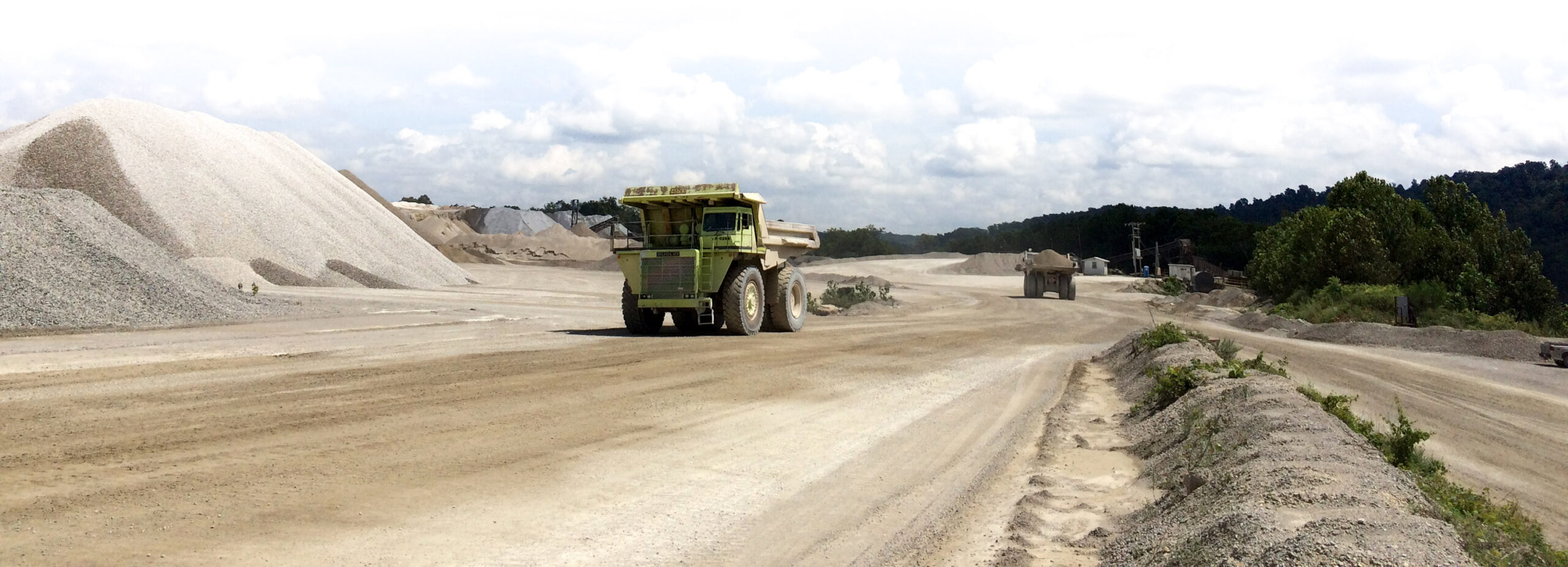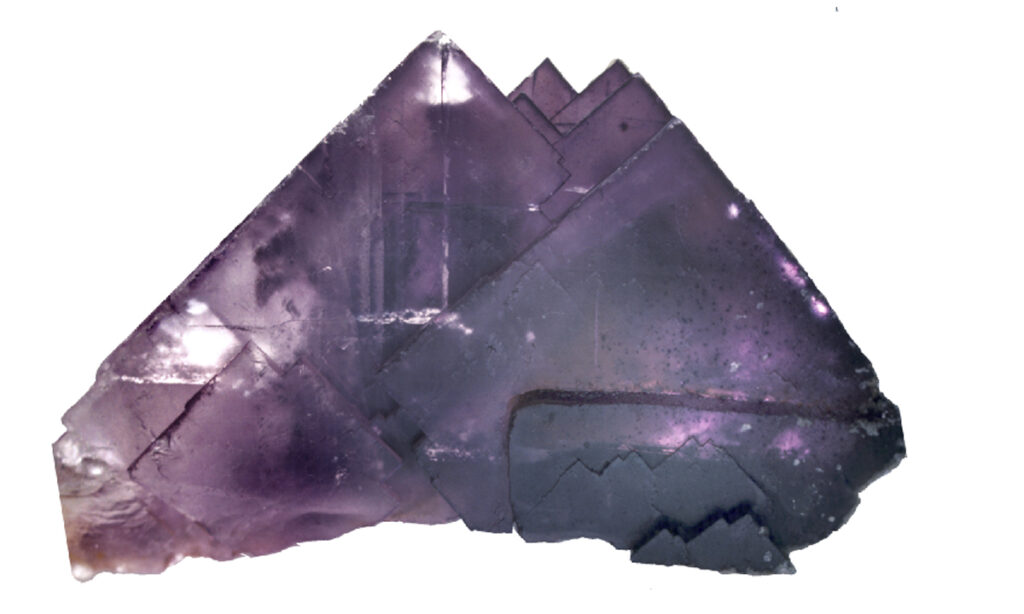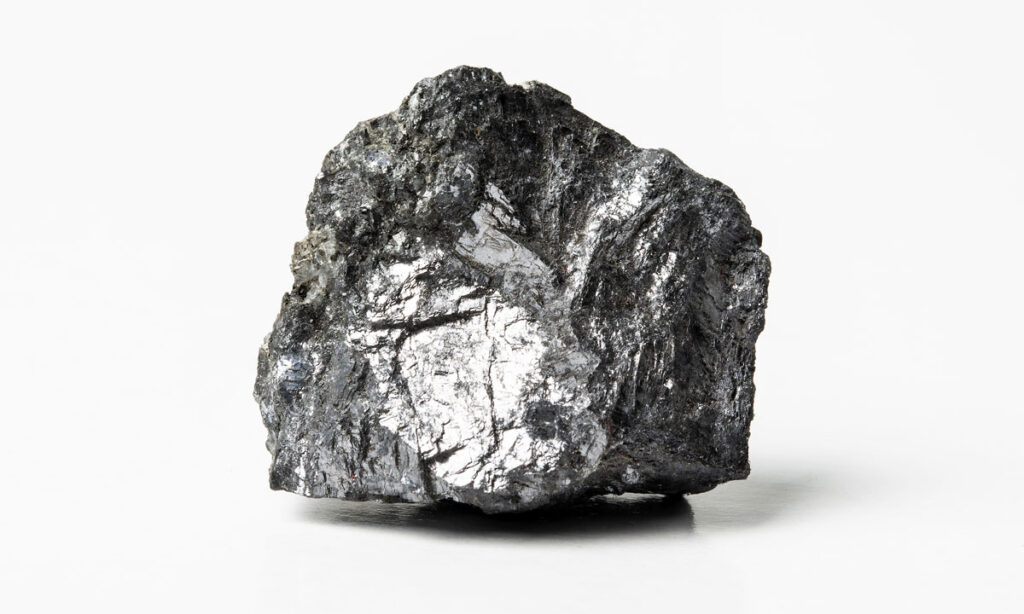Propelling Innovation
PRI and Illinois’ Industrial Evolution
The Illinois State Geological Survey (ISGS), part of the Prairie Research Institute, plays a vital role in researching and analyzing Illinois’ mineral resources, including coal, fluorite, lead, limestone, and sand and gravel. Their work has been instrumental in mapping reserves, guiding sustainable mining practices, and informing policy decisions.
ISGS’ research in areas like the coal industry and the fluorite sector has provided essential data for industry growth and adaptation. The survey’s insights into lead mining, particularly in the Galena region, have shed light on the industry’s socio-economic impact. Additionally, ISGS’ detailed studies of limestone, sand and gravel have supported resource management and infrastructure planning, underlining the survey’s significant impact on Illinois’ industrial landscape.

Chronicling coal in Illinois
Coal was one of the first economic resources recognized within the Illinois Basin in the 1670s, and coal mining has played a vital role in the Illinois economy since the 1820s. These coal resources formed from plant debris in swamps and peat bogs during the Mississippian and Pennsylvanian Periods (360 million to 300 million years ago).
The principal coal-bearing geologic formation and most significant coal seams found in Illinois have played a significant role in the state’s economy and have impacted society in various ways:
- Carbondale Formation: This geologic interval contains the two most important coal seams in Illinois, the Herrin and Springfield coals. Over 90% of all minable coal in Illinois comes from these two coal seams, with extensive historical mining and mining still ongoing today. Both seams are known for being high-quality bituminous coal, crucial for electricity generation and industrial processes.
- Danville Coal Member: A locally important seam in Vermilion County, mined with some of the earliest steam-powered shovel surface operations in the state and country.
- Herrin Coal Member: The most voluminous and economically important coal seam in the state. Approximately 9.4 billion tons of coal have been mined from this seam and over 51 billion tons remain potentially available for extraction.
- Springfield Coal Member: The second most voluminous coal seam. Almost 2.2 billion tons mined, and over 27 billion tons are potentially available.
- Murphysboro Coal Member: Locally important in southwestern Illinois contributing to the local coal mining industry and power generation in southern Illinois.
- Colchester Coal Member: A widely distributed, but thin coal, at one point this was an important coal for the city of Chicago and northern Illinois. Today the spoil piles remaining from its extraction and processing may become vital resources for rare earth elements, critical for the renewable energy transition.
In total, almost 13 billion tons of coal have been mined in Illinois contributing greatly to the economic development and energy of Illinois, and 96 billion tons remain to be potentially mined. To put that number in perspective, the heat energy contained in those 96 billion tons of Illinois coal is equivalent to the heat energy of all the oil reserves of Saudi Arabia and Kuwait combined.
Coal mining in Illinois, as a commercial enterprise, dates back to 1810, when a drift mine was opened in the bluff bordering the Big Muddy River, several miles below Murphysboro. Considerable amounts of coal were undoubtedly being mined by 1831 in various parts of the state, although no production figures were collected by the government until 1833. In that year, 6,000 tons were hauled to St. Louis from the Belleville district alone. The U.S. Census Report for 1840 took notice of production in 19 separate counties in Illinois, which produced a total of approximately 17,000 tons.
By this time, governmental authorities had begun to take notice of the new science of geology and the potential value of geological studies for locating and mapping mineral resources. Governor French, in a message to the Illinois legislature on January 7, 1851, recommended legislation to establish a geological survey in Illinois.
“We have unmistaken evidence,” he said, “that this state is scarcely excelled in the extent of her mineral riches, and all that seems wanting to render them richly productive is to point attention to them. As some considerable time will be required for a careful and minute geological survey of the whole state, I would respectfully suggest whether its importance would not justify a limited appropriation, to be followed by others thereafter, as the results and prospects of success might render desirable.”
“Historic geological mapping and research serve the purpose of a data archive,” said Scott Elrick, geologist and head of the coal, bedrock geology and industrial minerals section at ISGS. “If that research had not happened then, we would not be doing the research that we are doing now.”
Dr. J.G. Norwood was appointed State Geologist in October 1851. He continued to serve until 1858 but, except for a small, approximately accurate geological map of the state, prepared very little material for publication. His sole contribution in the way of a published report was a brochure of less than 100 pages, mostly coal analyses and diagrams of local geological sections.
By the mid-19th century, the coal industry in Illinois was expanding rapidly in harmony with the rapid construction of railroads. Before 1850 there were approximately 59 miles of railroad lines in Illinois, which ballooned to 2,781 miles in merely a decade. Coal production in Illinois increased from 260,000 tons in 1849, to 728,400 tons in 1860, and reached the million-ton mark by 1864. The rapid growth of mining activity, and the need for authoritative geological data to guide development, made necessary the continuation of a geological survey.
The discovery of extensive coal reserves and the completion of the Illinois & Michigan Canal in 1848 fueled Chicago’s growth as a transportation hub attracting many immigrants, particularly from Germany and Ireland, seeking work in construction, factories and emerging industries.
The rapid industrialization of Chicago and other Illinois cities during this period drew large numbers of immigrants and led to the establishment of numerous mining towns, driving population growth and fostering the development of railroads to transport coal to urban markets. As industries flourished, the demand for Illinois coal surged, cementing its role as a vital energy source for factories, homes, and later, power plants.
Throughout the 20th century, Illinois’ coal underpinned the state’s manufacturing sector, providing the energy needed for steel production, heavy industry, and wartime demands. However, the coal industry also experienced volatility, with periods of boom and bust influenced by factors like labor disputes, economic downturns and competition from other energy sources.
Despite these challenges, the economic imprint of coal mining is deeply etched in Illinois’ history, contributing significantly to its economic development. The industry’s legacy is also reflected in the infrastructure, culture and community identity of the regions where coal mining was predominant.
The state has a long history of coal mining, contributing significantly to national coal output. Illinois ranks third among the 50 U.S. states in all-time coal production — Pennsylvania and West Virginia are the only states with higher cumulative coal production than Illinois.
As the state transitions toward sustainable energy, the historical importance of coal remains a defining chapter in Illinois’ industrial narrative, although its role is changing due to environmental concerns and shifts toward renewable energy sources.
Environmental considerations, such as land disturbances from mining operations, water pollution from mine runoff, and air pollution from burning coal have led to regulatory changes, environmental restoration efforts and shifts in energy policy to mitigate negative impacts. The coal industry’s future in Illinois is influenced by economic factors, environmental regulations and the transition to cleaner energy sources.
“It’s the invisible force of science that propels innovation and development forward,” said Brown.
ISGS scientists have found untapped and extensive supplies of many critical minerals in coal waste piles and coal seams. The Illinois Basin Carbon Ore, Rare Earth, and Critical Mineral Initiative (IB CORE-CM) will assess the potential for advanced mining techniques and state-of-the-art separation and mineral extraction technologies to produce these mineral resources from coal and coal waste in and around the Illinois Basin, which underlies most of Illinois and extends into southwestern Indiana and western Kentucky.
The project will define a plan for a technology innovation center to address analytical challenges, extraction requirements, resource assessments and product creation specific to Illinois Basin carbon ore, rare earth and critical minerals and to serve as a focus for outreach, industry participation and the pursuit of commercial opportunities.
The project also will determine what local infrastructure is needed to produce CORE-CM resources for U.S. industry and stimulate regional economic growth.
Rare Earth Elements (REEs) from coal ash ponds and waste piles and critical substances like graphite from coal feedstocks are used in large amounts in electric vehicle batteries. The oncoming renewable energy and electric vehicle revolution will require extensive quantities of REEs as well as lithium, barite, zinc and others.

Illinois’ fluorite factor
Fluorite, the state mineral of Illinois, has played a crucial role in Illinois’ economic and industrial development. Notably used as a flux in steelmaking and aluminum production and as a source of fluorine in toothpaste, fluorite was mined primarily in the southern parts of the state, within the Illinois Basin called the Illinois-Kentucky Fluorspar Mining District. This region was one of the largest producers of fluorite in the U.S., supplying a critical material for steel manufacturing and other industries.
Well-documented in detailed reports by ISGS, particularly in Circular 604, a comprehensive exploration of the era when the southern Illinois Basin, especially the Illinois-Kentucky Fluorspar Mining District, was a national leader in fluorite production.
The economic impact of fluorite mining was profound, particularly in towns like Rosiclare, once known as the “Fluorspar Capital of the World.” The mining industry created jobs and sustained local economies, transforming these communities into bustling hubs of activity. Fluorite’s utility extended beyond primary industries to the manufacture of hydrofluoric acid, which is crucial in the chemical sector, and it played significant roles in ceramics and glass manufacturing. These varied applications underline fluorite’s critical importance in both industry and everyday life.

However, the story of fluorite mining in Illinois also encompasses environmental and health challenges. ISGS’s work in environmental geology underscores the importance of responsible mining practices and the need to balance industrial activities with environmental health and public safety. This aspect of their work highlights the complexities inherent in the mining industry.
Despite its historical significance, the demand for Illinois fluorite declined due to global market changes, leading to a reduction in local mining operations. Nevertheless, the legacy of fluorite mining endures. Its designation as the State Mineral of Illinois and the preservation of its history in museums, particularly in regions that were once mining hotspots, signify its enduring cultural and historical importance.
But the future looks bright for fluorite.
Renewed interest in fluorite and associated minerals, plus the discovery of REEs, makes this region poised for revitalization as demand for critical minerals increases. ISGS continues to play a critical role in documenting the past and paving the way for future explorations and innovations in the realm of critical minerals. In conclusion, the story of fluorite in Illinois weaves a narrative of industrial strength, economic growth, and environmental stewardship. ISGS’ research and documentation efforts have been instrumental in preserving and understanding the legacy of fluorite mining, ensuring its ongoing relevance and appreciation in Illinois’ industrial history.
Lead’s landmark legacy: Galena’s impact on Illinois
Lead mining is an integral part of the state’s industrial history, tracing its origins back to the early 1700s. Illinois’ lead and zinc district, which is nestled in the upper Mississippi Valley region, primarily spans Jo Daviess, Carroll, and Stephenson counties, with a predominant focus in Jo Daviess County. This area, rich in mineral resources, has played a pivotal role in the development of the region’s economy and infrastructure.
Throughout the 19th century, the industry flourished, with Illinois playing a crucial role in the production of lead, particularly during the period surrounding the Mexican War. The district’s sedimentary geology includes formations such as Niagaran dolomite, Maquoketa shale, and Galena dolomite—named after the city of Galena, a central hub in the region’s mining activities.
The city, named for the natural form of lead sulfide, was the site of one of the first major mineral rushes in the United States, predating the more famous California Gold Rush by several decades. Galena, Illinois, was a major center for lead mining during the 19th century.
The lead deposits in Galena were first mined by Native Americans and then by pioneer settlers, leading to the displacement of the indigenous people who originally mined the area. The region’s lead resources became the focus of the first major mineral rush in the United States in the 1820s, with Galena rivaling Chicago in size by the end of that decade.

At its peak in 1845, the upper Mississippi Valley lead and zinc mining district, with Galena as its hub, shipped a record 54,494,850 pounds of lead and produced almost 85% of the nation’s lead. This remarkable production level contributed significantly to the city’s growth and economic prosperity during that period.
The industry’s growth created a ripple effect, benefiting various sectors and contributing to the economic vitality of Illinois during the 20th century. However, with the decline of the lead mining industry and the onset of the California Gold Rush, Galena’s population began to decline. Despite this, the city’s rich legacy remains, making it a significant site for understanding the industrial history of the United States. In the early 2000s, ISGS scientists partnered with the Illinois Department of Public Health and Jo Daviess County Health Department to determine the sources of the high lead concentrations found in the blood of Galena-area children. Along with the area’s history of lead and zinc mining, the soil contains naturally high levels of lead. The survey acquired mine maps and other historical records from the last active mining company in the area. Those archives are being used in conjunction with other ISGS data to produce an updated digital map of the known lead and zinc mining sites in the county, providing valuable information to identify the source of lead contamination in the area.
Limestone processing
Illinois’ limestone legacy
Limestone mining in Illinois began with the early European settlers in the 1830s, but it was the introduction of concrete roads that marked a significant turning point. The need for superior limestone aggregate for road construction became apparent, leading to more focused and extensive mining efforts.
In 1925, a pivotal study by ISGS, in collaboration with the State Highway Division, delved into the state’s rich limestone resources. This comprehensive study was not just about sourcing quality material for road construction; it aimed to understand and harness Illinois’ geological resources.
Beyond road construction, Illinois’ limestone has proven essential in various industries. It plays a critical role in manufacturing Portland cement, acts as a flux in iron and copper smelting and is used in producing agricultural limestone. Its versatility extends to building stone in construction, as well as uses in the glass and paper industries, and even in whiting production. The diverse quality requirements of these industries underscore the resource’s importance and versatility.
With the guidance of ISGS, quarrying in Illinois has transformed into a sophisticated practice, merging geological expertise with strategic planning. Site selection for quarries is influenced by market demands, transportation facilities and competitive factors. Advanced mining methods efficiently extract limestone abundantly found in counties like Will, Hancock, Cook, Kankakee, St. Clair, McHenry, Rock Island and Adams, ensuring a steady supply of quality material essential for the state’s transportation infrastructure, construction industry and regional economies.
Chicago’s architectural and infrastructural evolution is deeply intertwined with Illinois limestone. The city’s iconic buildings and infrastructure, constructed extensively with limestone from nearby Cook County and surrounding areas, have not only shaped its aesthetic character but also underpinned its growth as a center of architectural innovation. The use of limestone in Chicago’s development has had a significant economic impact, stimulating the quarrying industry and creating jobs, thereby playing a crucial role in the city’s historical and economic development.
This limestone legacy, initiated for road construction, has blossomed into a multifaceted industry, integral to Illinois’ economy and infrastructure development. The comprehensive research by ISGS remains a testament to the enduring value and versatility of Illinois’ limestone resources.
Sand and gravel pit
Illinois‘ sand and gravel industry
Sand and gravel, integral to the construction industry, have a significant presence in Illinois, both in geological formations and economic impact. ISGS has played a critical role in mapping and analyzing these resources, shedding light on their distribution and economic value.
The geological formation of sand and gravel deposits in Illinois is largely attributed to the glacial activities that occurred over millennia. The most recent glaciation, the Wisconsin Glaciation, significantly influenced the state’s landscape, resulting in the extensive sand and gravel deposits that are found today. The variation in particle size and composition of these aggregates reflects the diverse environmental conditions of their deposition, as detailed in ISGS studies.
Economically, the sand and gravel industry has been a cornerstone of Illinois’ economy. According to John M. Masters’ 1983 ISGS publication, the industry contributed approximately $150 million annually to Illinois’ economy in the early 1980s, with a steady annual growth rate of about 5%. This growth was mirrored in societal developments, particularly in infrastructure projects. The Illinois Department of Transportation, for instance, reported a 20% increase in aggregate use for road construction from 1975 to 1985, underscoring the industry’s vital role in state development projects.
The industry’s progression over the decades is captured in Irma Samson’s 1984 directory, which lists over 300 active sand and gravel production sites across Illinois. This marked a significant increase from the 1950s when there were less than half as many sites. The directory also highlights a shift in production methods; in the 1960s, less than 10% of the sites employed dredging methods, but by the early 1980s, this figure had risen to around 30%. Such changes reflect advancements in extraction technology and adaptations to accessing deeper deposits.
Environmental considerations have also been pivotal in the industry’s evolution. The implementation of the Surface Mining Control and Reclamation Act of 1977 led to improved reclamation practices in over 70% of the mining sites by the mid-1980s, demonstrating the industry’s response to environmental concerns. As Illinois continues to develop, the role of sand and gravel, backed by the foundational research of ISGS, remains a critical component of the state’s economic and infrastructural framework.
Illinois’ industrial story is indelibly marked by the substantial influence of its natural resources, and the waves of resource demand over time. Industrial minerals like coal and fluorite, along with aggregates such as limestone, dolomite, sand, and gravel, have not only powered economic engines but have also laid the foundation for the state’s infrastructure and cultural tapestry. These resources have shaped the demographic and physical contours of Illinois, influencing the lives of its people in profound ways.
Each chapter marks an advancement in technology, changes in global economies and transportation, energy needs, climate change, and more — all geared toward the needs of a society in transition.
However, ISGS has remained a steadfast presence throughout history. ISGS has consistently adapted its resource science to meet the evolving needs of society, a reflection of its agile approach to applied geoscience.
Through meticulous research and documentation, ISGS continues to embody a commitment to environmental responsibility and scientific integrity. By judiciously managing natural wealth, ISGS is helping to steer Illinois toward an industrial future that is both sustainable and thriving, ensuring that the state’s rich resource legacy continues to benefit current and future generations.